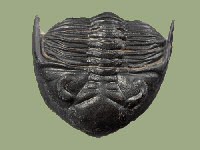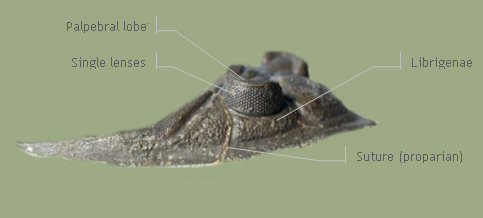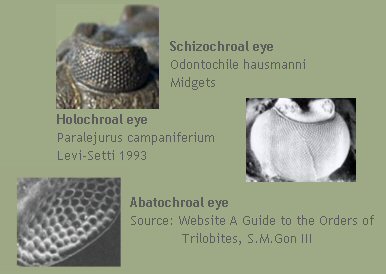|
|
|
TRILOBITA::
Homepage:: Trace fossils:: Preparation:: Cabinet:: Literature:: Links:: Geological Time:: Special:: Explanations::
The Team :-)
Comments:: The Arthropoda:: Exoskeleton:: The Cephalon:: Trilobites eyes:: Limbs:: Enrollment:: Habitats::
Trilobite Orders::
|
The Eyes- To see and to become viewed - |
|
The formation of visual faculty can be defined into three grades overall the orders. Primary blind trilobites liberated no kind of visual system within the scope of their evolution. With the species of secondary blind trilobites, fully functional eyes developed during their previous evolution were reduced an finally lost during further evolution. Such evolutionary trends were never curious and occured in various trilobites orders. Possible coming from light conditions prevalented species bentic e. g. dimmed or even lack of light in deep- water bentic, where trilobites have gradually lost their visual systems without suffering an adaptive disadvantage in relationship to an advantage over deep- water bentic life. The third grade finally representing the viewing trilobites with eyes. At the latter's grade schizochroal, holochroal and abathochroal eyes are to be differentiated. Basically the eyes of trilobites consisted of an assembly of many lenses, material based of calcite (crystalline structure). Calcite, chemically considered as a calcium carbonate (CaCo3), is clear as crystal at maximum purity with an high birefringence. It's presumed the respective receptors were Inside of the single prisms (derived from the construction of the compound eyes of today's Arthropods).
Schizochroal eyes
Schizochroal eyes are merely to be found at some representatives of the Order Phacopida. This kind of eyes are consisting about 700 single lenses, each covered by a separate corneal membrane (cornea) and seperated from it's neighbours lenses by a tunic membran (sclera). Compared to this type, one holochroal eye consist of a close packing of up to over 15000 hexagonal outlined biconvex lenses. A single corneal layer covers all of the lenses. Holochroal eyes have no sclera. The abatochroal type of eyes is only to be found in a few Cambrian trilobites of Suborder Eodiscina (Kobayashi, 1939). This type consits of up to circa 70 little single lenses, each with it's own cornea. The corneal membrane doesn't extend inside the eye, and it ends at the edge of the lens. The thin sclera is ending in lenses depth. |
|
|
|
|
|
|
|
|
|
|
|
|




